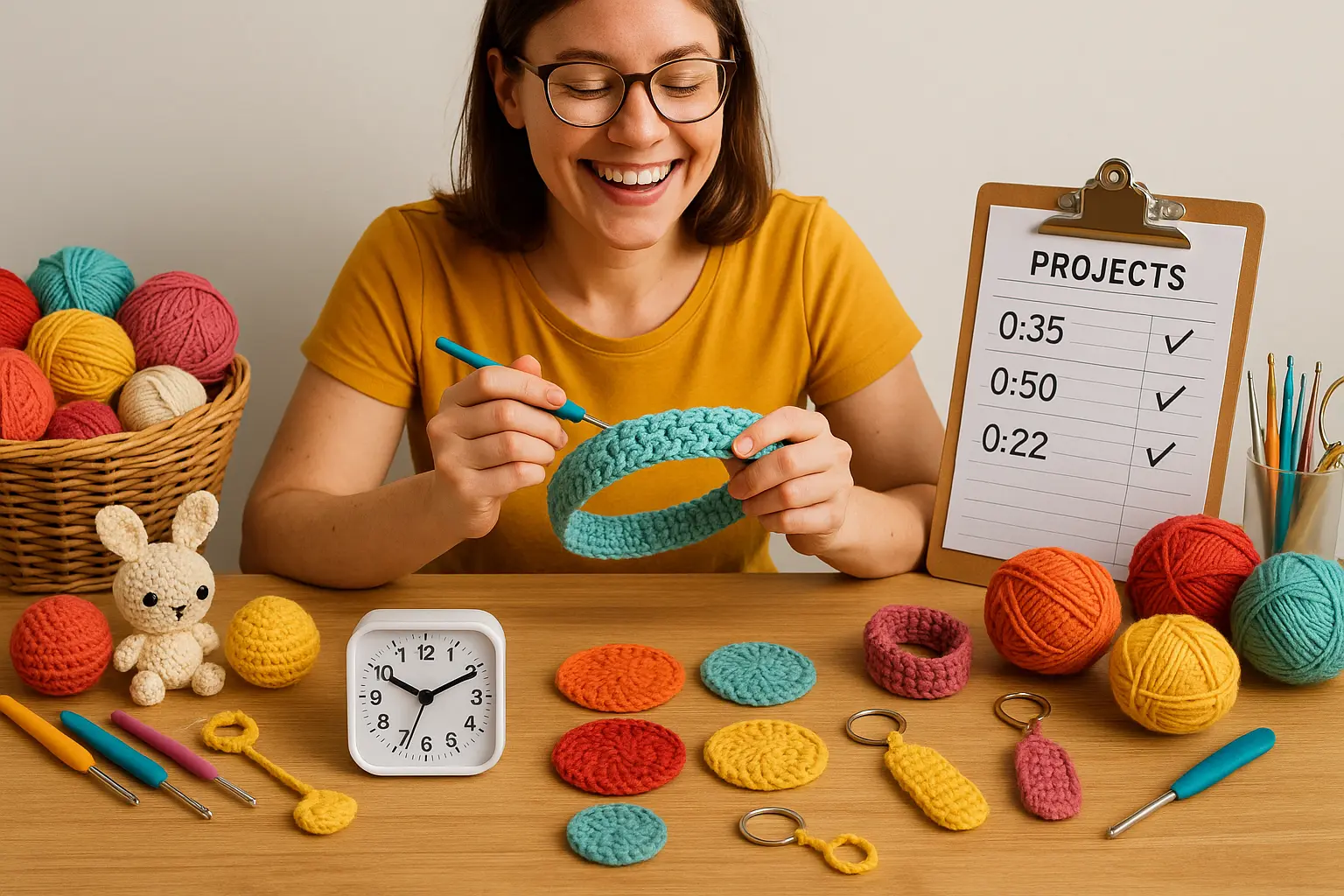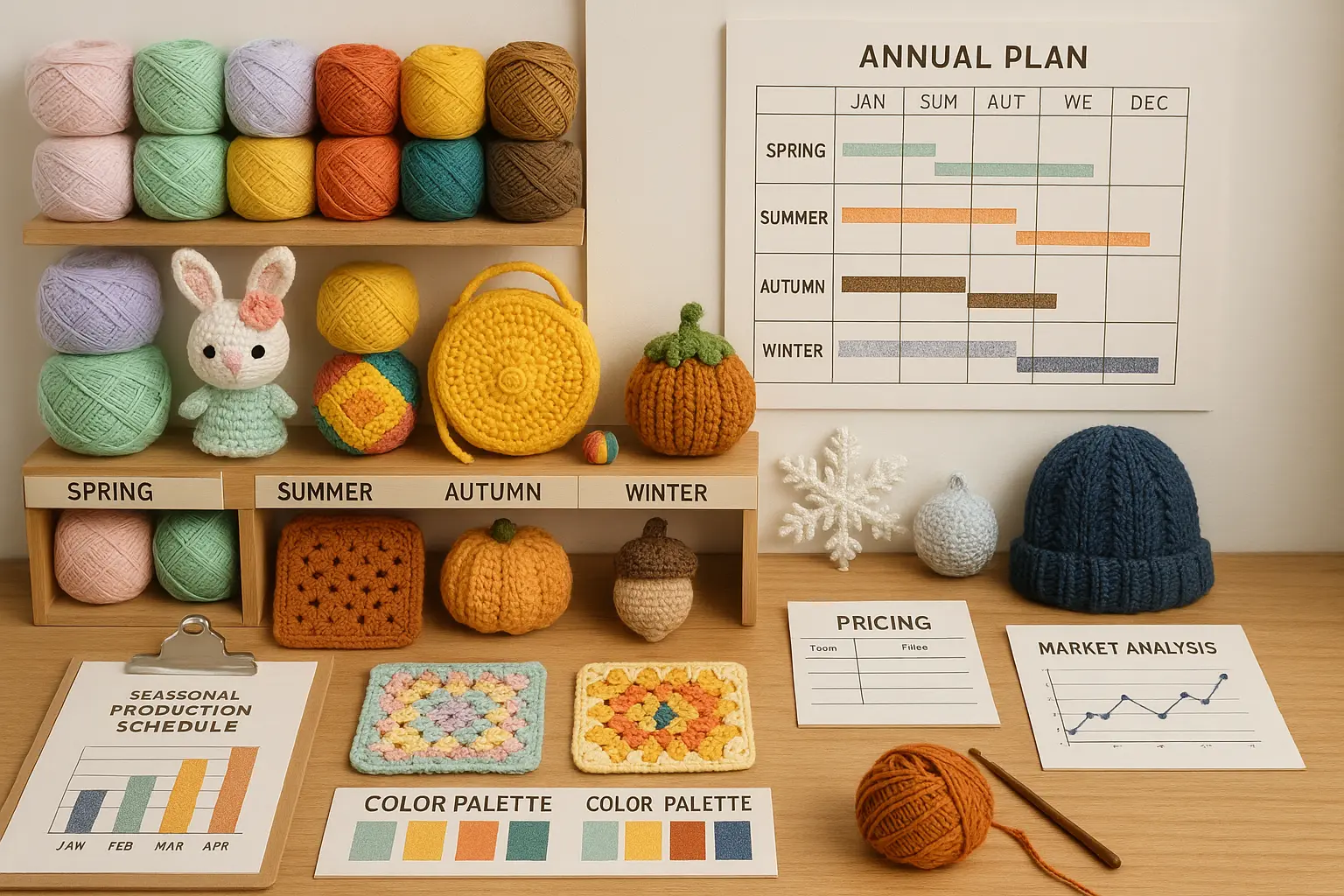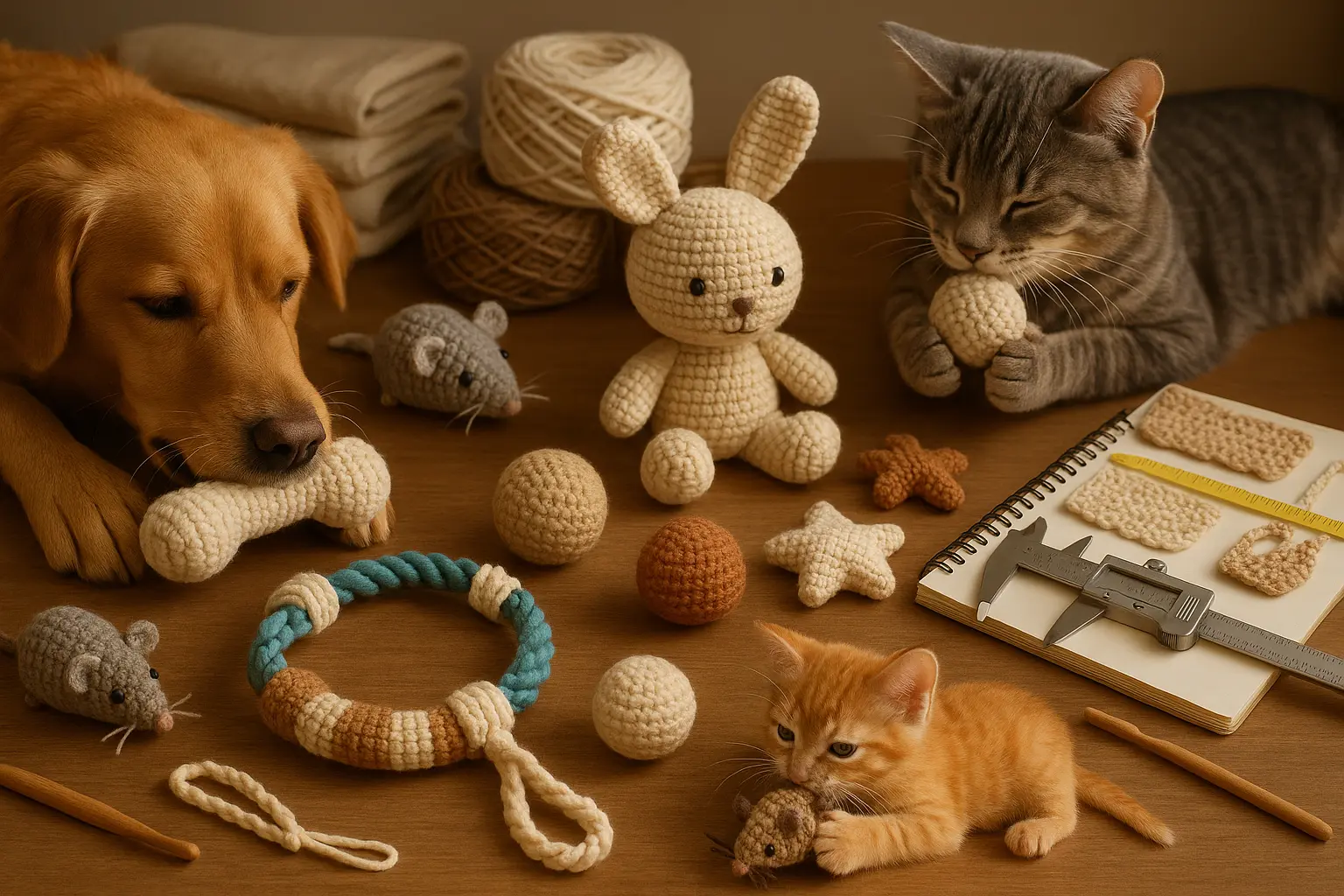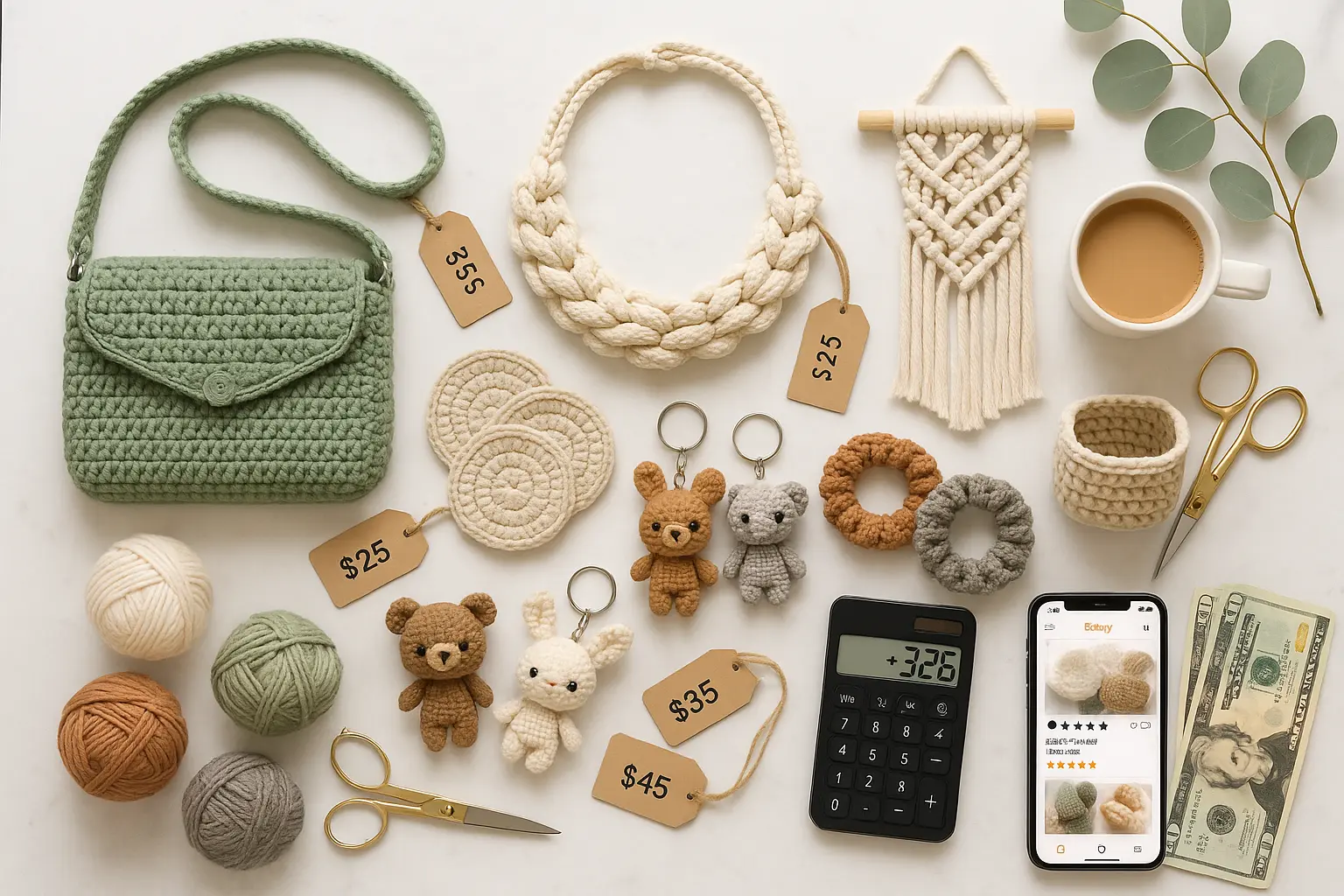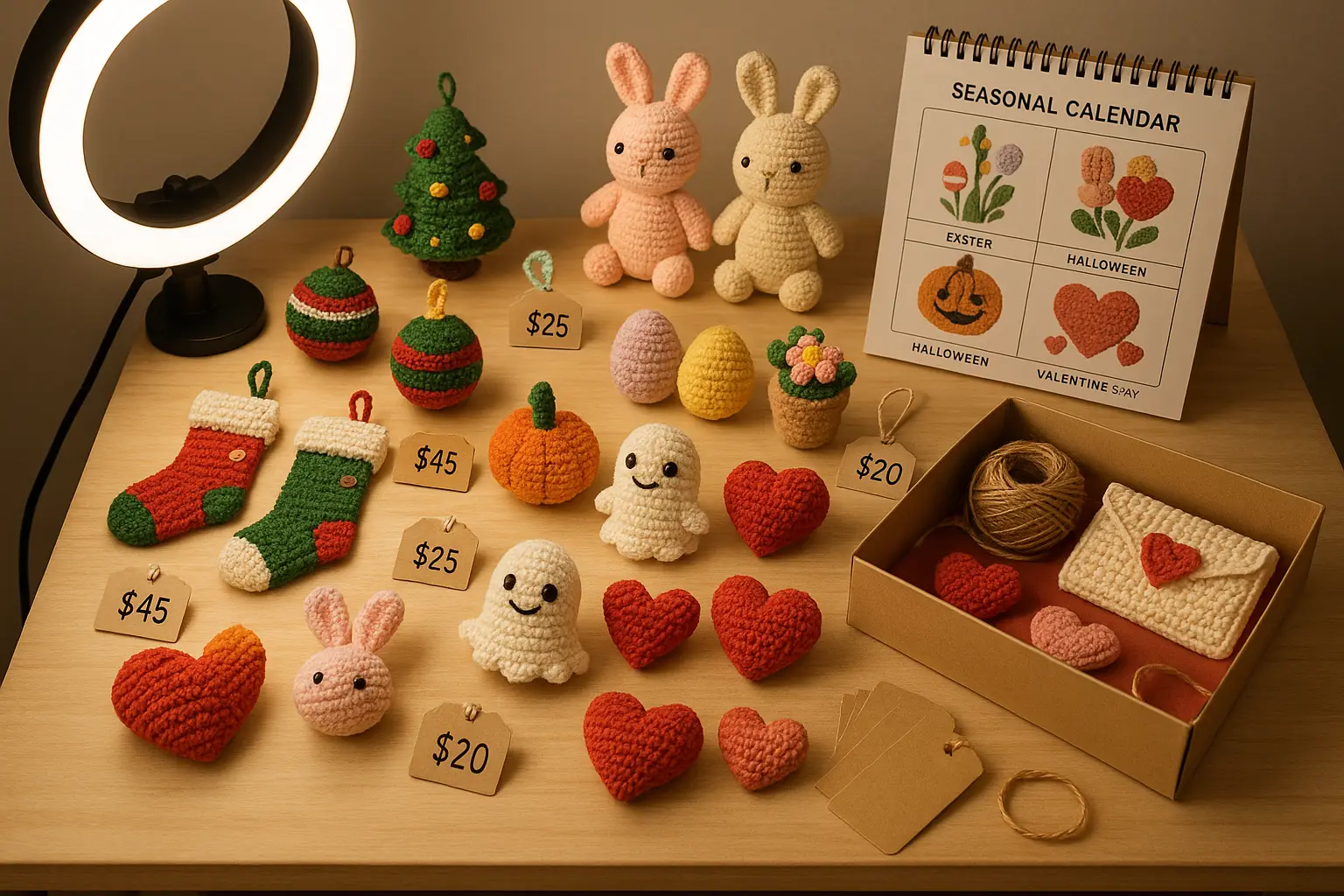Quick crochet projects serve as essential skill-building exercises while providing the immediate satisfaction crucial for maintaining momentum in creative practice. Research from occupational therapy studies shows that completing projects within 2-hour timeframes triggers dopamine release patterns that reinforce positive associations with the craft, leading to 40% higher long-term engagement rates compared to those who start with lengthy projects. For crocheters at any level, quick projects offer strategic pathways to skill development, gift creation, and business prototyping that build confidence while creating practical, beautiful items.
This comprehensive guide reveals the time management strategies, project selection criteria, and efficiency techniques that enable maximum creative output within minimal time investment. Whether you're building foundational skills, creating last-minute gifts, or developing products for potential business ventures, these proven approaches help you achieve professional results quickly while maintaining quality standards that justify your time investment.
Strategic Value of Quick Project Mastery
Understanding quick projects as skill development tools rather than just time-fillers enables strategic approach that maximizes learning and creative growth within limited time windows.
Skill Development Acceleration
Progressive Skill Building: Quick projects provide concentrated practice opportunities that build specific skills without overwhelming time commitments that can lead to project abandonment.
Technique Mastery Through Repetition:
- Stitch consistency: Repeated practice in short sessions builds muscle memory faster than sporadic long sessions
- Pattern recognition: Quick projects expose crafters to various pattern structures efficiently
- Problem-solving skills: Frequent project completion builds confidence in troubleshooting and adaptation
- Quality standards: Regular finishing practice develops professional-level completion skills
Confidence Building Psychology: Completing projects regularly creates positive feedback loops that encourage continued learning and more ambitious project attempts. Each finished piece provides tangible evidence of skill development while building trust in personal abilities.
Business Development Applications:
- Product prototyping: Quick projects enable rapid testing of marketable item concepts
- Market research: Fast completion allows testing customer response to different designs
- Production efficiency: Developing speed and quality consistency for potential business scaling
- Gift market preparation: Building inventory of gift-appropriate items for various occasions
Learn foundational techniques in our Crochet Basics for Beginners comprehensive guide.
Time Management and Productivity Benefits
Scheduled Creativity: Quick projects enable productive use of small time windows that would otherwise be unproductive, making creative practice possible within busy lifestyles.
Productivity Psychology:
- Momentum maintenance: Regular project completion maintains creative momentum between larger projects
- Skill retention: Frequent practice prevents skill deterioration during busy periods
- Stress management: Quick creative accomplishments provide mental health benefits
- Goal achievement: Regular completion builds achievement-oriented mindset
Flexible Practice Integration:
- Commute projects: Portable items suitable for travel and waiting periods
- Break activities: 15-30 minute sessions that refresh focus during work breaks
- Social crafting: Projects appropriate for crafting while socializing or watching television
- Learning windows: Time slots dedicated to practicing new techniques without long-term pressure
Project Categories by Time Investment
Lightning-Fast Projects (15-30 minutes)
Foundation Building Items: These ultra-quick projects focus on basic skill development while creating immediately useful items.
Essential Beginner Projects:
- Chain practice accessories: Bracelets and bookmarks that build consistent tension
- Single crochet squares: Coasters and potholders teaching fundamental stitches
- Simple geometric shapes: Building blocks for understanding construction principles
- Color change practice: Items incorporating basic color transitions
Skill Development Benefits:
- Tension control: Consistent gauge development through repetitive practice
- Stitch recognition: Building ability to identify and count stitches accurately
- Pattern following: Introduction to written pattern interpretation
- Finishing techniques: Learning to weave ends and create clean edges
Practical Applications:
- Cleaning cloths: Useful household items that encourage daily use and pride
- Gift tags: Personalized elements for gift presentation
- Coasters: Functional items that protect furniture while showcasing skills
- Pet toys: Simple, safe toys for family pets that provide immediate utility
Moderate Projects (30-90 minutes)
Skill Integration Opportunities: These projects combine multiple techniques while remaining achievable within single crafting sessions.
Intermediate Skill Builders:
- Textured scarves: Incorporating multiple stitch patterns for visual interest
- Shaped accessories: Items requiring basic increases and decreases
- Color work patterns: Projects integrating multiple colors systematically
- Three-dimensional construction: Introduction to working in rounds and shaping
Advanced Quick Projects:
- Cable patterns: Learning cable techniques on manageable scale
- Lace elements: Introduction to openwork patterns and chart reading
- Construction methods: Comparing different approaches to similar items
- Customization practice: Adapting patterns for personal preferences
Market-Ready Items:
- Headbands: Fashionable accessories with broad appeal and gift potential
- Phone cases: Modern utility items that demonstrate technical competence
- Cup cozies: Practical items with customization potential for cafes and gifts
- Keychains: Small items with high gift appeal and business potential
Learn intermediate techniques in our Intermediate Crochet Skills development guide.
Extended Quick Projects (90-120 minutes)
Complex Skill Development: These projects approach the upper limit of "quick" while providing substantial skill development and finished pieces with significant value.
Advanced Construction Practice:
- Amigurumi basics: Introduction to three-dimensional construction principles
- Garment elements: Sleeves, pockets, and other components that build toward larger projects
- Joining techniques: Various methods for connecting pieces professionally
- Professional finishing: Blocking, seaming, and presentation standards
Business Development Projects:
- Product line samples: Testing designs for potential business applications
- Custom order prototypes: Developing items for client presentation
- Photography models: Creating items specifically for marketing and demonstration
- Teaching samples: Projects designed for instructional use
Strategic Project Selection Framework
Skill Level Matching
Beginner Optimization: New crocheters benefit from projects that build confidence through guaranteed success while introducing fundamental concepts systematically.
Success-Oriented Selection:
- Single technique focus: Projects emphasizing one new skill rather than multiple challenges
- Forgiving materials: Yarns and patterns that hide minor irregularities
- Practical outcomes: Items with clear utility that encourage continued use and pride
- Clear instructions: Well-written patterns with comprehensive guidance
Progressive Difficulty Sequencing:
- Foundation projects: Basic stitches and construction methods
- Combination projects: Integrating multiple familiar techniques
- Challenge projects: Introducing one new element to familiar framework
- Confidence projects: Demonstrating mastery before advancing to next level
Time Constraint Management
Realistic Time Assessment: Accurate time estimation prevents frustration while enabling successful project completion within available windows.
Time Calculation Factors:
- Skill level impact: Beginners require 2-3x longer than experienced crocheters
- Complexity variables: Pattern reading, color changes, and shaping add time
- Quality standards: Higher finishing standards require additional time investment
- Interruption accommodation: Real-world time includes setup, breaks, and cleanup
Efficiency Development:
- Workspace organization: Efficient setup reduces project time overhead
- Tool familiarity: Using comfortable, familiar tools increases speed
- Pattern preparation: Pre-reading patterns eliminates mid-project delays
- Material readiness: Having supplies prepared and accessible
Explore efficiency techniques in our Advanced Crochet Techniques guide.
Materials and Tools Optimization
Yarn Selection for Speed and Success
Quick Project Yarn Characteristics: Choosing appropriate yarns significantly impacts both project completion time and final quality.
Optimal Yarn Properties:
- Worsted weight versatility: Most patterns designed for this standard weight
- Smooth texture: Enables faster hook movement and stitch formation
- Good stitch definition: Shows techniques clearly for learning purposes
- Forgiving nature: Hides minor tension inconsistencies while learning
Color Strategy:
- Solid colors: Easier to work with while learning techniques
- Light colors: Better stitch visibility for accuracy and learning
- Personal appeal: Colors that motivate completion and pride in results
- Practical considerations: Colors appropriate for intended use
Value vs. Quality Balance:
- Learning projects: Affordable yarns appropriate for skill building
- Gift projects: Higher quality materials that reflect care for recipients
- Prototype projects: Standard quality for testing before investment in premium materials
- Display projects: Premium materials for items intended for photography or presentation
Tool Selection for Efficiency
Hook Optimization: The right hooks significantly impact both speed and comfort during quick project sessions.
Ergonomic Considerations:
- Comfortable grip: Reduces hand fatigue during intensive sessions
- Smooth material: Enables faster yarn movement and reduced friction
- Appropriate size: Correct hook for yarn weight ensures proper gauge
- Quality construction: Consistent hook shape maintains stitch uniformity
Essential Quick Project Tools:
- Stitch markers: Critical for maintaining accurate stitch counts
- Sharp scissors: Clean cuts that prevent fraying and waste
- Yarn needles: Variety of sizes for different finishing requirements
- Measuring tools: Ensuring accurate sizing for functional items
Learn professional tool selection in our Crochet Tools Guide.
Efficiency Techniques and Time Management
Production Speed Development
Systematic Speed Building: Developing efficient working methods enables more ambitious projects within quick timeframes while maintaining quality standards.
Technique Efficiency:
- Consistent rhythm: Developing steady, sustainable working pace
- Ergonomic positioning: Body position that prevents fatigue and strain
- Hook handling: Efficient hook movement that minimizes wasted motion
- Yarn management: Techniques that prevent tangling and maintain flow
Pattern Navigation Speed:
- Pre-reading: Understanding entire pattern before beginning work
- Marking systems: Highlighting and notation for quick reference
- Progress tracking: Systems for maintaining position in complex patterns
- Reference organization: Quick access to abbreviations and special instructions
Quality Maintenance Systems
Speed vs. Quality Balance: Maintaining professional standards while working quickly requires systematic approaches to quality control.
Real-Time Quality Control:
- Regular gauge checks: Ensuring consistent sizing throughout project
- Stitch count verification: Preventing errors that require extensive correction
- Tension monitoring: Maintaining uniform fabric density
- Progress assessment: Regular evaluation of work quality and appearance
Efficient Error Management:
- Early detection: Identifying problems before they compound
- Quick fixes: Techniques for correcting minor errors efficiently
- Prevention strategies: Working methods that minimize error occurrence
- Recovery techniques: Salvaging work when significant errors occur
Business Applications and Market Development
Product Development and Testing
Rapid Prototyping Benefits: Quick projects enable efficient testing of business concepts without substantial time and material investment.
Market Research Applications:
- Customer feedback: Testing market response to design concepts quickly
- Production feasibility: Determining time requirements for business scaling
- Material costs: Calculating accurate costs for pricing decisions
- Quality standards: Establishing minimum quality levels for business products
Portfolio Development:
- Photography samples: Creating items specifically for marketing materials
- Demonstration pieces: Items for teaching workshops and classes
- Gift market testing: Developing items for seasonal and occasion markets
- Custom order samples: Examples for client consultations and quotes
Skill Monetization Strategies
Teaching and Workshop Applications: Quick projects provide ideal content for educational services and community engagement.
Educational Service Development:
- Beginner workshops: Projects designed for single-session learning experiences
- Skill-specific classes: Focused instruction on particular techniques
- Corporate workshops: Team-building activities using quick, achievable projects
- Community service: Charity workshops that create useful items while teaching
Digital Product Opportunities:
- Pattern sales: Quick patterns appeal to time-constrained customers
- Video tutorials: Short-form content suitable for social media and online sales
- Skill courses: Comprehensive instruction using progression of quick projects
- Subscription content: Regular delivery of new quick project patterns
Learn business development in our Crochet Business Success comprehensive guide.
Gift Creation and Social Applications
Last-Minute Gift Solutions
Emergency Gift Strategies: Quick projects provide solutions for unexpected gift needs while demonstrating thoughtfulness through handmade effort.
Occasion-Appropriate Projects:
- Birthday accessories: Items customizable with recipient's favorite colors
- Holiday decorations: Seasonal items that show thoughtful preparation
- Thank you gifts: Small tokens that express appreciation meaningfully
- Housewarming items: Practical gifts that welcome friends to new homes
Personalization Techniques:
- Color customization: Adapting projects to recipient preferences
- Size modifications: Adjusting patterns for specific needs
- Embellishment addition: Adding personal touches that increase meaning
- Message integration: Including written cards or tags with handmade items
Community and Charitable Applications
Service Project Development: Quick projects enable meaningful community service without overwhelming time commitments.
Charitable Contributions:
- Shelter donations: Practical items for homeless shelters and transitional housing
- Hospital gifts: Comfort items for patients and families
- School donations: Educational tools and comfort items for classrooms
- Senior care: Items bringing comfort and engagement to elderly residents
Community Building:
- Group projects: Collaborative efforts that build social connections
- Skill sharing: Teaching others while completing meaningful projects
- Cultural preservation: Creating items that honor traditional techniques
- Environmental awareness: Using sustainable materials and methods
Long-term Strategy and Skill Development
Progressive Skill Building Architecture
Systematic Development Planning: Using quick projects strategically builds comprehensive skills while maintaining motivation through regular accomplishment.
Skill Development Sequencing:
- Foundation phase: Mastering basic stitches and construction principles
- Integration phase: Combining techniques and developing personal style
- Specialization phase: Focusing on specific areas of interest or expertise
- Innovation phase: Developing original techniques and design approaches
Portfolio Documentation:
- Progress tracking: Photographing projects to document skill development
- Technique catalog: Building reference library of mastered techniques
- Style evolution: Recording personal aesthetic development over time
- Achievement celebration: Recognizing milestones and breakthrough moments
Transition to Complex Projects
Bridge Project Strategy: Quick projects serve as stepping stones toward more ambitious endeavors by building confidence and specific skills.
Complexity Progression:
- Technique building: Using quick projects to master components of larger projects
- Time management: Developing sustained focus through progressive project lengths
- Quality standards: Establishing professional expectations through achievable projects
- Creative confidence: Building trust in personal abilities and aesthetic judgment
Learn advanced applications in our Long-Term Crochet Projects masterpiece guide.
Transform Quick Projects Into Lasting Success
Quick crochet projects represent more than time-filling activities - they provide strategic pathways to skill mastery, creative confidence, and potential business development. The systematic approach to quick project selection and execution builds comprehensive capabilities while providing immediate satisfaction that maintains long-term engagement with the craft.
Success with quick projects requires balancing speed with quality, choosing appropriate challenges for current skill levels, and understanding each project as investment in overall creative development. This strategic mindset transforms quick sessions into meaningful skill building that supports both personal satisfaction and potential professional applications.
Development Insight: Successful crocheters consistently report that mastering quick projects provided the confidence and skills foundation that enabled them to tackle increasingly ambitious projects while maintaining quality standards and creative satisfaction.
The key lies in approaching each quick project as deliberate practice rather than casual activity, using time constraints as motivation for efficiency while maintaining standards that build pride and capability.
Start Building Skills Through Strategic Quick Projects
Ready to transform available time into meaningful skill development and beautiful creations? Our Complete Amigurumi Mastery Bundle includes comprehensive collections of quick projects, efficiency techniques, and progressive skill building strategies that have helped over 900 students develop confidence and competence through strategic quick project practice.
The bundle provides systematic approaches to project selection, time management, and skill development that maximize learning within minimal time investment while building toward advanced capabilities and potential business applications.
Discover how quick projects accelerate skill development while providing immediate creative satisfaction - join successful crocheters who understand that strategic quick project practice builds the foundation for all future crochet achievements.
Additional Resources for Quick Project Success
Foundation Building:
- Crochet Basics for Beginners - Essential techniques for quick project success
- Beginner-Friendly Projects - Extended collection of accessible projects
- Intermediate Crochet Skills - Advancing through quick project practice
Efficiency and Excellence:
- Advanced Crochet Techniques - Professional methods for quick projects
- Crochet Tools Guide - Optimal tools for efficiency and quality
- Pattern Tips Guide - Efficient pattern reading and modification
Applications and Development:
- Crochet Business Success - Monetizing quick project skills
- Long-Term Crochet Projects - Progression from quick to complex projects
- Kid-Friendly Crochet - Teaching through quick projects
External Resources:
- Ravelry - Extensive quick project pattern database
- Craft Yarn Council - Time estimation and skill level standards
Quick crochet projects provide strategic pathways to skill mastery, creative confidence, and practical accomplishment. This efficient approach to craft development builds comprehensive capabilities while maintaining the immediate satisfaction essential for long-term creative engagement.
